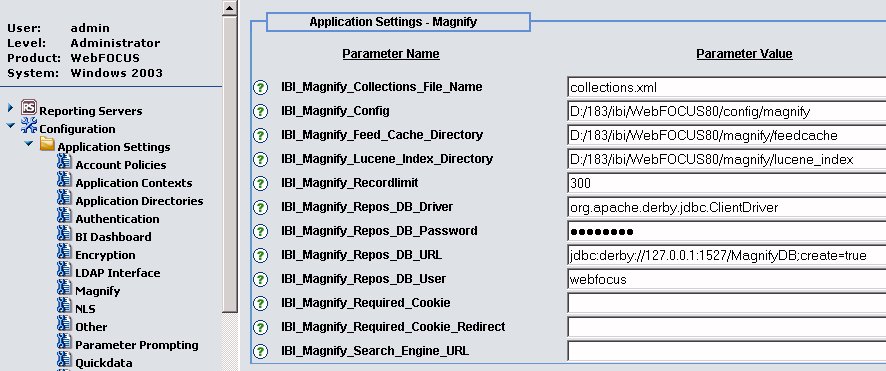To set the search engine parameters in WebFOCUS:
-
In the left pane of the WebFOCUS Administration Console, select
Configuration, then Magnify.
The following image shows the WebFOCUS Administration Console with the default Settings for Magnify in the right pane.

-
Type values (or accept the default values) for the remaining parameters:
- IBI_Magnify_Collections_File_Name
-
Specifies the file name where the Lucene® indexes and collections are defined. By default, the Magnify installation provides a collections.xmltemplate file in the \ibi\WebFOCUSxx\config\magnify directory, which defines default values for analyzers. This file can be renamed to collections.xml and modified to reflect the desired settings for your Magnify environment.
-
For more information on configuring collections of indexes, see Configuring Magnify Collections.
- IBI_Magnify_Config
-
Specifies the full path to the directory where the configuration files are located.
If your installation needs to make changes to the configuration directory, you should move this directory outside of the ibi directory. This ensures that future WebFOCUS upgrades do not overwrite your configuration information.
The default path is ibi\config\magnify.
- IBI_Magnify_Feed_Cache_Directory
-
Specifies the directory where Magnify stores records which are not yet loaded into the index. The files stored in this directory are files which are generated from the iWay Service Manager feed process. After all content is added to the Lucene index, the cached version is moved or deleted depending on the magnify_generate_deltas variable value of true or false. An index during a quiecse is loaded into the index after the backup of the Lucene index is complete.
The default value is ibi\magnify\feedcache.
- IBI_Magnify_Lucene_Index_Directory
-
Specifies the full path to the directory where the default Lucene index resides. This is only active for the Lucene search engine.
The default directory is ibi\magnify\lucene_index.
Additional search directories are configured in config\magnify\collections.xml.
- IBI_Magnify_Recordlimit
-
Specifies the maximum number of search results returned by a search request. Any results beyond this number are not displayed to the user. The default value is 300.
- IBI_Magnify_Required_Cookie
-
If a HTTP cookie name is specified, Magnify verifies that the cookie is set. If the required cookie does not exist, Magnify displays the Web page specified by the IBI_Magnify_Required_Cookie parameter. If the parameter is set to false or is blank (the default value), Magnify does not verify any cookies.
- IBI_Magnify_Required_Cookie_Redirect
-
Specifies the Web page that Magnify displays if the HTTP cookie specified by the IBI_Magnify_Required_Cookie parameter does not exist in the browser session of the user.
- IBI_Magnify_Search_Engine_URL
-
Specifies the URL search engine. Currently, we are in support of Apache Lucene 2.94. The GSA is no longer supported as of WebFOCUS Version 8.0.0. For more information on using the GSA with Magnify Version 7 Release 7.03 or earlier, see Using Magnify with the Google Search Engine.
The following are the internal database connection settings used by the Magnify dynamic partitioning database. If using a database other than Derby, the database connection settings must be modified accordingly.
Note: In addition to configuring the database connection settings, the \ibi\WebFOCUSxx\utilities\WFReposUtil\MagnifyCreateDDL.bat (for Windows) or MagnifyCreateDDL.sh (for UNIX) must be executed to create the Dynamic Partitioning database tables.
- IBI_Magnify_Repos_DB_Driver
-
Specifies the database driver of the Magnify database. If using a Derby database, the default value is org.apache.derby.jdbc.ClientDriver. By default, this is the same value as the IBI_Repos_DB_Driver parameter in the Repository section under the Configuration menu.
- IBI_Magnify_Repos_DB_Password
-
Specifies the password used to connect to the Magnify database. The default value is webfocus. Otherwise, it is the same value as the IBI_Repos_DB_Password parameter in the Repository section under the Configuration menu.
- IBI_Magnify_Repos_DB_URL
-
Specifies the connection url to the Magnify database. For example, jdbc:derby://localhost:1527/MagnifyDB;create=true.
- IBI_Magnify_Repos_DB_User
-
Specifies the user ID used for connections to the Magnify database. The default value is webfocus. Otherwise, it is the same value as the IBI_Repos_DB_User parameter in the Repository section under the Configuration menu.
- Click Save.
Configuration of the search engine for Magnify is complete.
